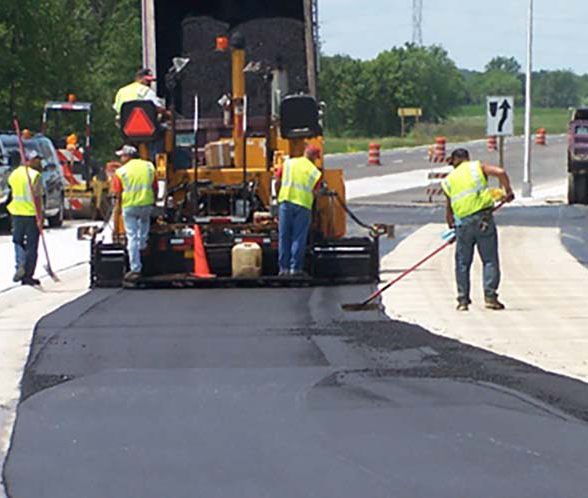Hot Mix Asphalt Paving: Redefining Commercial Residential Or Commercial Property Landscapes
Hot Mix Asphalt Paving: Redefining Commercial Residential Or Commercial Property Landscapes
Blog Article
Opening the Tricks of Hot Mix Asphalt Modern Technology
Exploring the depths of warm mix asphalt technology uncovers a globe where precise procedures and specific solutions merge to form our roadways and framework. The combination of accumulations, binders, and fillers isn't merely a construction task yet a tactical orchestration of sturdiness and efficiency. As we peer into the complex dance of parts, a tapestry of durability and sustainability unravels. What lies under this surface of asphaltic mastery, and what tricks wait to be introduced in the world of paving advancements?
Relevance of Warm Mix Asphalt
Hot Mix Asphalt plays an important duty in modern-day facilities advancement as a result of its durability and cost-effectiveness. As one of the most typically used leading material for roadways, highways, and car park, Hot Mix Asphalt provides a series of benefits that contribute to its relevance in building and construction jobs. One crucial benefit is its ability to withstand rush hour lots and severe climate condition, providing a reputable and long-lasting surface for transportation networks. Furthermore, Warm Mix Asphalt is cost-efficient in both initial building and construction and long-lasting upkeep, making it a favored selection for lots of framework jobs.
The longevity of Hot Mix Asphalt stems from its composition, which consists of accumulations, binder, and filler materials that are thoroughly chosen and mixed to fulfill details performance needs. Overall, the relevance of Warm Mix Asphalt in infrastructure growth can not be downplayed, as it continues to be a foundation of modern building and construction methods.
Components of Asphalt Mixes
The make-up of asphalt mixes consists of very carefully picked aggregates, binder, and filler materials that are vital for attaining specific performance demands. Accumulations are the key component of asphalt mixes, offering stamina and stability. The binder, generally bitumen or asphalt concrete, holds the aggregates with each other and supplies versatility and resilience to the mix.
The mix and percentage of these elements play a considerable duty in establishing the quality and performance of the asphalt mix. Engineers thoroughly develop the mix to satisfy certain demands, thinking about aspects like website traffic quantity, environment problems, and pavement life expectancy. Appropriate selection and balancing of accumulations, binder, and fillers are necessary for producing resilient, long-lasting asphalt pavements.
Mixing and Manufacturing Strategies

Once the aggregates are chosen, the binder, commonly asphalt concrete, is contributed to bind the products with each other. The binder's top quality and amount dramatically influence the mix's resistance, toughness, and adaptability to ecological aspects. Furthermore, fillers like hydrated lime or Portland cement might be included to improve certain attributes of the asphalt mix, such as its workability or wetness resistance.
During production, the accumulations and binder are warmed, normally in between 250-325 ° F(121-163 ° C ), to help with blending and guarantee proper coating of the the original source accumulations. The blending process must be thorough to attain an uniform mix that promotes the wanted performance characteristics of the asphalt. Numerous methods, such as batch blending or drum blending, are employed to achieve premium and consistent asphalt blends for building projects.
Aspects Impacting Asphalt Efficiency
Variables influencing asphalt efficiency include a series of variables that affect the sturdiness, long life, and general quality of asphalt sidewalks. One key variable is the quality of products used in the asphalt mix. The kind and source of accumulations, the binder quality, and the ingredients all play a significant duty in identifying the efficiency of the asphalt pavement. The rank of aggregates is important as it affects the mix's resistance, stability, and workability to fracturing and rutting.

Environmental conditions likewise influence asphalt performance. Temperature level variants, dampness seepage, and traffic lots can all impact the architectural integrity of the discover here sidewalk. Layout considerations, such as sidewalk thickness and drain, are important in making certain the long-lasting efficiency of the asphalt pavement. By very carefully considering these designers, service providers and elements can optimize asphalt performance and improve the life span of pavements.
Sustainable Practices in Asphalt Technology

WMA permits for the manufacturing and positioning of asphalt blends at reduced temperature levels compared to typical hot-mix asphalt, resulting in reduced energy consumption and greenhouse gas discharges. The use of permeable asphalt mixes can assist mitigate stormwater overflow concerns by allowing water to penetrate through the pavement and right into the ground, promoting natural water purification and recharge processes.
Verdict
To conclude, warm mix asphalt technology plays an important duty in modern-day infrastructure development due to its toughness and cost-effectiveness. By meticulously stabilizing components, employing proper mixing techniques, and thinking about different aspects, designers can produce top notch asphalt blends that hold up against rush hour lots and rough climate condition. Welcoming lasting techniques, such as utilizing warm-mix innovations and recycled materials, even more enhances the environmental kindness of asphalt modern technology.
Blending and Source production techniques in hot mix asphalt modern technology entail the exact combination and processing of accumulations, binder, and fillers to produce a long lasting and high-performance asphalt mix.Elements influencing asphalt efficiency include a range of variables that impact the longevity, long life, and general quality of asphalt sidewalks. Lasting practices in asphalt modern technology incorporate different initiatives intended at decreasing the ecological effect of asphalt production and paving procedures. By including redeemed asphalt sidewalk (RAP) and recycled asphalt shingles (RAS) right into new asphalt blends, the market can significantly lower the usage of raw products and energy, while additionally reducing landfill waste.
WMA enables for the production and positioning of asphalt blends at lower temperature levels compared to typical hot-mix asphalt, resulting in decreased power consumption and greenhouse gas exhausts.
Report this page